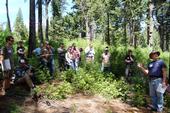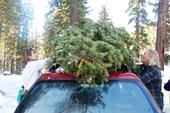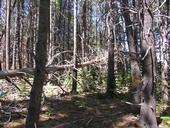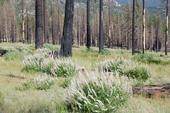- Author: Jeannette E. Warnert

After academics complete fire science research, the results often end up gathering dust on a shelf. UC Cooperative Extension is now playing a significant role in bridging the gap between wildland fire science and wildland managers across the United States.
“It is a classic disconnect,” said Susie Kocher, UC Cooperative Extension advisor in the Central Sierra office. “That's why Cooperative Extension was formed almost 100 years ago. Policymakers could see that research advances weren't being implemented on farms. The same thing has happened in natural resource management.”
For example, Kocher said, scientists have known since the 1960s that systematic...
- Author: Jeannette E. Warnert

Every year, the day after Thanksgiving, Susie Kocher bundles up her children, gathers the extended family and hikes into the Lake Tahoe Basin forest to find a Christmas tree.
“It’s my favorite part of the season,” Kocher said. “Having the fresh, living thing in the house really symbolizes the holiday. You can’t do it with a fake tree.”
Kocher, a forester and the natural resources advisor for UC Cooperative Extension in the Central Sierra, lives and works in Lake Tahoe. The Lake Tahoe Basin Management District is one of nine national forests in California, all...
- Author: Jeannette E. Warnert

Many parts of the Sierra Nevada have not burned in more than 100 years, a significant departure from a natural fire cycle that would characterize a healthy forest, according to Susie Kocher, UC Cooperative Extension advisor in the Central Sierra office.
“The fire interval is completely out of whack compared to pre-settlement conditions,” Kocher said.
In a historical, natural and healthy fire regime, nearly half of Sierra forests would experience fire every 12 years and three-quarters would burn every 20 years. However, only 0.2 percent of Sierra forest land has burned repeatedly at least every 20 years in modern times, while 74 percent has not had a single...
- Author: Susie Kocher

In the many forested areas where wildfires are currently burning, the question will soon arise: What should be done after the fire goes out? That depends on the severity of the burn and land owner goals.
For high severity burns where very few or no live trees remain to provide seed for the next generation, forest recovery can take a very long time. Typically forest landowners want to restore their lands to a forested condition as quickly as possible. In that case, an active approach can help them reach their goal sooner.
The California Tahoe Conservancy has just released a report on the outcomes of active restoration of 40 acres of Conservancy lands where...
- Author: Jeannette E. Warnert

If you are passionate about a forest near you then you may want to tune into the UC Cooperative Extension webinar series on Community Forests. The webinars will begin at 6:30 p.m. Pacific Standard Time on April 7 with additional programs on April 13, 20 and 27. Participants may also want to take part in related field trips to Arcata Community Forest, Usal Redwood Forest, Tahoe-Donner and Weaverville Community Forest.
Community forests are forested lands that are managed to produce what people value. Forests may be valued as a source of timber for lumber, clean water, wildlife habitat, recreational purposes or for all of these benefits in combination.
The webinar series aims to present an overview of community forestry...



